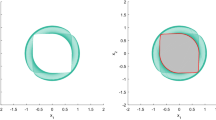Abstract
An extended semi-definite programming, the SDP with an additional quadratic term in the objective function, is studied. Our generalization is similar to the generalization from linear programming to quadratic programming. Optimal conditions for this new class of problems are discussed and a potential reduction algorithm for solving QSDP problems is presented. The convergence properties of this algorithm are also given.
Similar content being viewed by others
References
Alizadeh, F., Interior point methods in semidefinite programming with application to combinatorial optimization, SIAM J. Opt., 1995, 5: 13.
Alizadeh, F., Haeberly, J. P. A., Overton, M. L., Primal-dual interior point methods for semidefinite programming, Working Paper, RUTCOR Rutgers.
Fujisawa, K, Kojima, M., Nakata, K., Exploiting sparsity in primal-dual interior-point methods for semidefinite programming, Math. Prog., 1997, 79: 235.
Todd, M. J., Toh K, Tüitüncü, R. H., On the Nesterov-Todd direction in semidefinite programming, Technical Report No. 1154, School of Operations Research and Industrial Engineering, Ithaca: Cornell University, 1996.
Zhang, Y., On extending primal-dual interior-point algorithms from linear programming to semidefinite programming, to appear in SIAM J. Opt.
Zhao, Q., Karische, S. E., Rendl F. et al., Semidefinite programming relaxations for the quadratic assignment problem, CORR Rept 95-27, Ontario: Dept. of Combinatorics and Optimization, University of Waterloo, 1996.
Tseng, P., Search directions and convergence analysis of some infeasible path-following methods for the monotone semi-definite LCP, Optimization Methods and Software, 1998, 9: 245.
Kojima, M., Shindoh S., Hara, S., Interior-point methods for the monotone semidefinite linear complementarity problems, SIAM J. Opt., 1997, 7: 86.
Qi, H. D., Chen, X., On stationary points of merit functions for semi-definite complementarity problems, Report, ICMSEC, Beijing: Chinese Academy of Sciences, 1997.
Yin Yuye, Interior Point Algorithm Theory and Analysis, New York: John Wiley and Sons, 1998.
Golub, G. H., VanLoan,C. F., Matrix Computations, 3rd ed., Baltimore: Johns Hopskins University Press, 1996.
Klerk, E. de, Interior point methods for SDP, Ph. D Thesis, Delft: Delft University of Technology, 1997.
Author information
Authors and Affiliations
Rights and permissions
About this article
Cite this article
Nie, J., Yuan, Y. A potential reduction algorithm for an extended SDP problem. Sci. China Ser. A-Math. 43, 35–46 (2000). https://doi.org/10.1007/BF02903846
Received:
Issue Date:
DOI: https://doi.org/10.1007/BF02903846




